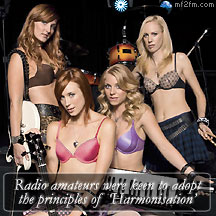Saturday 26 February, 2011, 02:18 - Amateur Radio
Posted by Administrator
On a number of previous occasions, Wireless Waffle has commented on actions being taken by various regulatory authorities which seem to be attacking the use of the 70 centimetre band by radio amateurs. But in the USA, things have just gotten a whole lot worse, with the tabling of a bill which suggests that two thirds of the (admittedly large) US 70cm allocation be given over to broadband services for first responders (or the emergency or blue light services as we call them over here).Posted by Administrator
 The bill, snappily entitled 'A bill to enhance public safety by making more spectrum available to public safety agencies, to facilitate the development of a wireless public safety broadband network, to provide standards for the spectrum needs of public safety agencies, and for other purposes.' or 'Broadband for First Responders Act of 2011' for short (herinafter referred to as 'the six million dollar bill') states, in section 207, subsection (d):
The bill, snappily entitled 'A bill to enhance public safety by making more spectrum available to public safety agencies, to facilitate the development of a wireless public safety broadband network, to provide standards for the spectrum needs of public safety agencies, and for other purposes.' or 'Broadband for First Responders Act of 2011' for short (herinafter referred to as 'the six million dollar bill') states, in section 207, subsection (d):Not later than 10 years after the date of enactment of this Act, the paired electromagnetic spectrum bands of 420–440 megahertz and 450–470 megahertz recovered as a result of the report and order required under subsection (c) shall be auctioned off by the Federal Communications Commission through a system of competitive bidding meeting the requirements of section 309 of the Communications Act of 1934.
The spectrum referred to in the aforementioned subsection (c) and in section 207, subsection (a) appears to refer to that which is freed by the cessation of use by public sector users who should migrate to the 700 and 800 MHz bands in the interim. However, there is little, if any, use of the frequency range 420 to 440 MHz by these users in the first place, as it is part of the amateur band. Indeed, according to the United Stated Frequency Allocations the band is only to be used by either radio amateurs (on a secondary basis), or by Government radiolocation services (eg the PAVE PAWS radar installations at the Clear, Beale and Cape Cod air-force bases). So, if taken literally, the frequencies in the range 420 to 440 MHz which would become available are - none, because none of them are used and thus none have been cleared! However, things are never that straightforward and it could be argued conversely that the fact that the first responders are not using that range of frequencies is a clear indication that they have cleared out of the band!
Either way, this assault on the 70cms band might be time for US amateurs to think carefully and propose something in their mutual interest. North of the border in Canada, the 70cm band stretches only from 430 to 450 MHz and in most of the rest of the world it is only 430 to 440 MHz (and as indicated before, there were moves afoot in Europe to further constrict this to 432 to 438 MHz). It may be, therefore, that agreeing a reduction in the US 70cm band to be in line with Canada at 430 to 450 MHz whilst in return guaranteeing some certainty of tenure would be a good way ahead. In Europe, for example, a reduction to 432 to 438 MHz in return for clearing out all those annoying low power devices around 433 and 434 MHz and also guaranteeing primary status for amateurs in the band would be a fair compromise. Or what about making the 70cm band 430-433 and 435-440 MHz, thereby leaving the low power devices to wallow in their own crapulence, sure this would require the re-tuning of many repeaters in the UK and elsewhere, but this is already having to be done in many cases due to the incoming and outgoing interference problems caused by the self-same low power devices.
 In many countries around the world, the frequency range 410 to 430 MHz is used for digital mobile radio systems which support blue-light activities. In the UK some spectrum in this range is available for use by the Ambulance service, for example. This means there is equipment available. Equally the band 450 to 470 MHz is similarly used. Therefore, giving US first responders the ranges 410 to 430 and 450 to 470 MHz makes a lot of sense and for once, means that the US frequency usage would be in harmony with that of most of the rest of the world and harmonisation leads to economies of scale and cost reductions and so forth, as its protagonisist are always keen to argue.
In many countries around the world, the frequency range 410 to 430 MHz is used for digital mobile radio systems which support blue-light activities. In the UK some spectrum in this range is available for use by the Ambulance service, for example. This means there is equipment available. Equally the band 450 to 470 MHz is similarly used. Therefore, giving US first responders the ranges 410 to 430 and 450 to 470 MHz makes a lot of sense and for once, means that the US frequency usage would be in harmony with that of most of the rest of the world and harmonisation leads to economies of scale and cost reductions and so forth, as its protagonisist are always keen to argue.Of course, any change in usage or allocation in a band leads to the need to re-plan, re-tune and re-think, but if the rest of the world's radio amateurs can cope with just 10 MHz of 70cm spectrum, and Canada can cope with 20 MHz, perhaps it is time for American amateurs to relinquish part of the band in the common good and figure out what they would like in return?
1 comment
( 1651 views )
| permalink
| 



 ( 2.8 / 71070 )
( 2.8 / 71070 )




 ( 2.8 / 71070 )
( 2.8 / 71070 )

